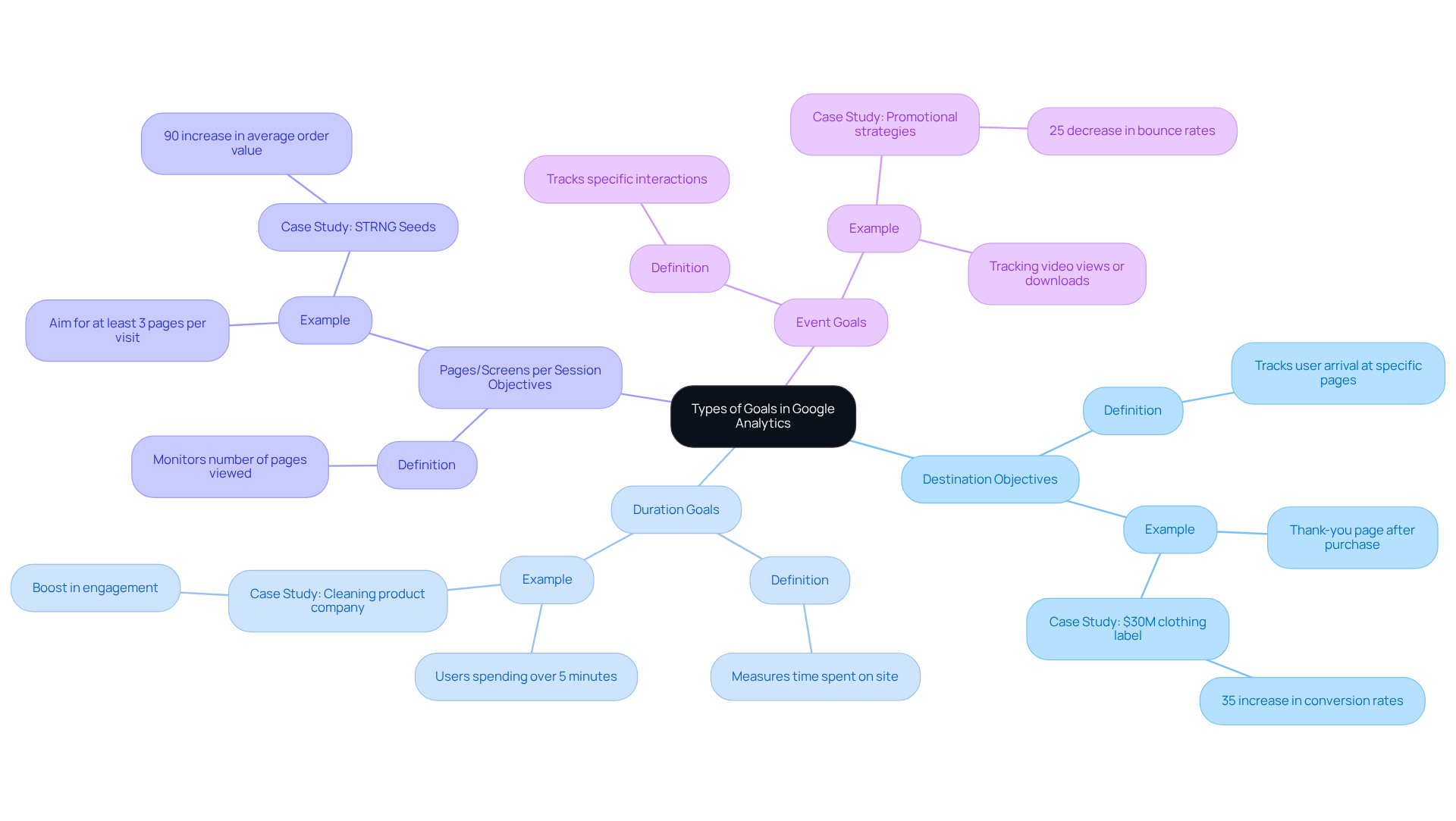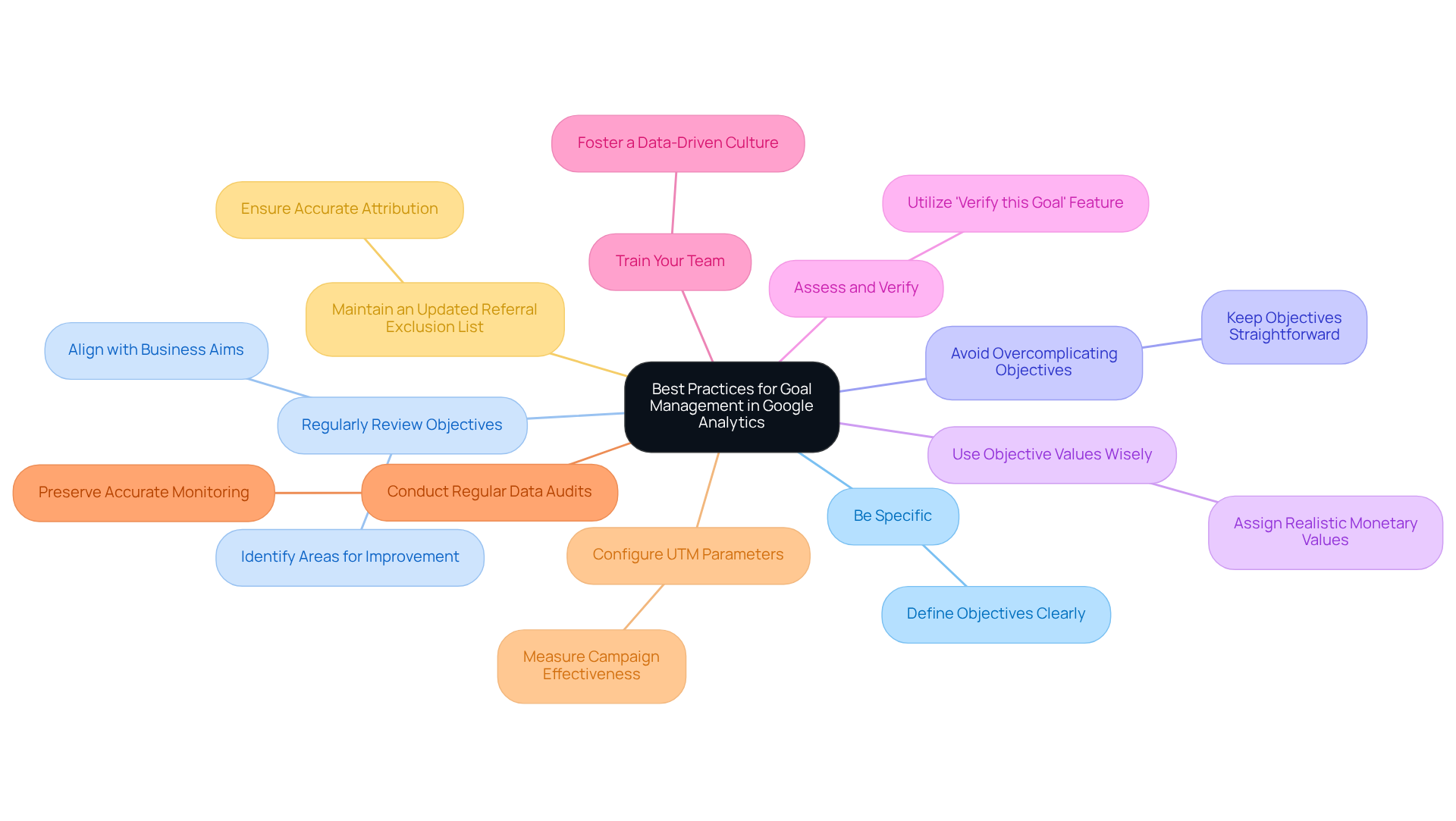
Overview
This article delves into how DTC brands can adeptly establish and manage Google Analytics goals, thereby enhancing their marketing strategies and improving conversion rates. It offers a comprehensive step-by-step guide for configuring goals, elucidates the various types of goals available, and underscores best practices for effective goal management. These elements are vital for measuring success and optimizing user experience in an increasingly competitive market.
Introduction
Mastering the intricacies of Google Analytics goals is crucial for direct-to-consumer (DTC) brands determined to enhance their online performance. By proficiently setting and managing these objectives, brands can uncover valuable insights into user behavior, refine marketing strategies, and ultimately propel revenue growth. Yet, numerous DTC companies face challenges with implementation, prompting the question: how can they ensure their goal-setting process yields meaningful results? This guide presents a comprehensive, step-by-step approach to mastering Google Analytics goals, equipping brands to leverage data-driven insights for sustainable success.
Understand Google Analytics Goals and Their Importance
The goal Google Analytics targets are specific objectives that empower DTC brands to evaluate how effectively their websites fulfill desired outcomes. These objectives encompass monitoring purchases, sign-ups, and other critical activities that drive revenue. Understanding and implementing these goals is essential for several reasons:
- Measure Success: Goals provide clear metrics for assessing the effectiveness of marketing efforts. For instance, e-commerce conversion rates typically range from 1-4%, and establishing specific targets enables companies to gauge their performance against industry benchmarks.
- Optimize Strategies: Analyzing objective achievements allows companies to discern which tactics yield results and which require enhancement. This iterative process is vital, as data-driven insights can significantly improve marketing ROI.
- Improve User Experience: By tracking user actions through objective completions, companies can fine-tune the customer journey, resulting in greater engagement and higher conversion rates. Research shows that returning customers convert at rates of 60-70%, highlighting the necessity of optimizing the user experience to cultivate loyalty.
In summary, setting the goal Google Analytics transcends mere technical configuration; it represents a strategic initiative that can profoundly influence a brand's growth trajectory. As emphasized by experts, effective measurement and objective monitoring are crucial for achieving sustainable success in the competitive DTC landscape.

Set Up Goals in Google Analytics: A Step-by-Step Guide
Establishing objectives in Analytics is essential for monitoring significant actions on your website and reaching your goal with Google Analytics through comprehensive Conversion Rate Optimization (CRO) strategies. Each step in this process directly contributes to improving your CRO efforts. To configure your goals effectively, follow these steps:
- Log into Google Analytics: Access your account and select the relevant property.
- Navigate to Admin: Click on the 'Admin' gear icon located in the bottom left corner.
- Select Goals: In the 'View' column, click on 'Goals'.
- Create a New Goal: Click on the '+ NEW GOAL' button to initiate the process.
- Choose a Template or Custom Objective: Select from available templates or create a custom objective tailored to your needs.
- Define Your Objective: Enter a descriptive name for your objective and select the type: Destination, Duration, Pages/Screens per session, or Event.
- Set Objective Details: Fill in the necessary details based on the objective type, such as the destination URL for a Destination objective.
- Assign a Value (Optional): Optionally, assign a monetary value to the objective to assess its impact on revenue.
- Verify the Goal: Use the 'Verify this Goal' option to check its potential conversion based on historical data. As Nicole C. W. emphasizes, always test if your objective works.
- Save Your Goal: Click 'Save' to finalize your goal setup.
By implementing these steps, DTC brands can leverage Analytics to enhance their marketing strategies, enabling data-driven decision-making and improved performance. This goal-setting process is a critical component of a holistic approach to CRO, ensuring that your paid ads and landing pages are aligned with the goal of Google Analytics to drive significant growth and higher conversion rates. Furthermore, remember that for Smart Goals, your AdWords account must have sent over 500 clicks to Analytics in the past 30 days, as noted by Grant Marlowe. Utilizing the 'DebugView' feature in GA4 can also assist in confirming your objectives are configured accurately by observing real-time event data.

Explore Different Types of Goals: Destination, Duration, Pages/Screen per Session, and Event Goals
Google Analytics provides four primary types of goals, each serving a distinct purpose that can significantly elevate the performance of direct-to-consumer (DTC) brands:
-
Destination Objectives: These objectives track when a user arrives at a specific page, such as a thank-you page after a purchase, making them ideal for assessing conversions. Monitoring visits to a confirmation page following a successful checkout is crucial for evaluating the effectiveness of your sales funnel. For instance, in a case study involving a $30M clothing label, optimizing the checkout process and monitoring destination objectives resulted in a remarkable 35% increase in conversion rates.
-
Duration Goals: These measure the length of time users spend on your site, offering insights into engagement levels. Establishing an objective for users who spend over 5 minutes on your site can indicate a strong interest in your content or products. A notable example is a cleaning product company that experienced a significant boost in engagement after implementing strategies encouraging longer site visits.
-
Pages/Screens per Session Objectives: This objective monitors the number of pages viewed during a session, aiding in the understanding of user engagement. Aiming for users to view at least 3 pages per visit can signal effective navigation and content relevance. In the case of STRNG Seeds, enhancing the user experience led to a staggering 90% increase in average order value (AOV) by encouraging deeper exploration of product offerings.
-
Event Goals: These track specific interactions on your site, such as video views or downloads, which are essential for measuring engagement with content. Tracking how many users click on a promotional banner can yield insights into the effectiveness of your marketing efforts. For example, establishing event objectives helped a company identify effective promotional strategies that resulted in a 25% decrease in bounce rates.
By understanding and applying these objective types, DTC companies can align their tracking with the goal of Google Analytics, leading to more informed marketing strategies and improved conversion rates. Parah Group's distinctive approach to conversion rate optimization (CRO) emphasizes profitability and sustainable growth, ensuring that goal setting is not merely a metric but a strategic tool for enhancing brand profitability and fostering sustainable development.

Avoid Common Pitfalls: Best Practices for Effective Goal Management
To ensure effective goal management in Google Analytics, it is crucial to implement best practices that align with your CRO strategies:
- Be Specific: Clearly define what each objective represents. Unclear objectives can lead to confusion and inefficient monitoring, obstructing your CRO initiatives.
- Regularly Review Objectives: Periodically evaluate your objectives to ensure they align with your current business aims and marketing strategies. Many DTC brands miss 20-25% of their revenue due to inaccurate tracking in Google Analytics. Regular reviews can help identify areas for improvement and enhance your overall CRO strategies.
- Avoid Overcomplicating Objectives: Keep your objectives straightforward. Excessively intricate objectives can weaken focus and hinder analysis, making it more challenging to obtain actionable insights that support your growth initiatives.
- Use Objective Values Wisely: Assign realistic monetary values to objectives based on historical data. This practice enhances understanding of the financial impact of your marketing efforts and supports your profitability maximization efforts.
- Assess and Verify: Regularly evaluate your objectives to ensure they are progressing accurately. Utilize the 'Verify this Goal' feature to check functionality and make necessary adjustments. This rigorous testing is essential for a high-velocity CRO approach.
- Train Your Team: Ensure that all team members comprehend the objectives and their significance. This fosters a data-driven culture within your organization, vital for implementing effective CRO strategies.
- Conduct Regular Data Audits: Frequent evaluations of your Google Analytics configuration can assist in preserving precise monitoring and insights, ensuring your analytics correspond with your business objectives and foster sustainable growth.
- Configure UTM Parameters: Properly setting up UTM parameters on campaign links is essential for measuring the effectiveness of your campaigns, ads, and social media posts. This data is crucial for refining your CRO strategies and maximizing profitability.
- Maintain an Updated Referral Exclusion List: This is crucial for accurate attribution of traffic sources, preventing misattribution of leads and sales to incorrect sources. Accurate attribution is key to understanding the effectiveness of your marketing efforts and optimizing your conversion rates.
By adhering to these best practices, DTC brands can enhance their goal management process with Google Analytics, resulting in more efficient monitoring and improved conversion rates. As Anton Koekemoer notes, 'In the latest version of Google Analytics, GA4, Goals have been replaced by Conversions,' emphasizing the importance of tracking high-value actions that directly impact business objectives and profitability.

Conclusion
Mastering Google Analytics goals transcends mere technicality; it is a pivotal strategy that can significantly amplify the growth and profitability of DTC brands. By establishing clear objectives, companies can adeptly track their performance, optimize marketing strategies, and enhance the overall user experience. The implementation of these goals transforms data into actionable insights, empowering brands to navigate the complexities of the digital landscape with confidence.
This guide has underscored the importance of understanding and setting up Google Analytics goals, detailing specific types such as:
- Destination
- Duration
- Pages/Screens per Session
- Event Goals
Each type serves a distinct purpose that, when leveraged effectively, can lead to substantial improvements in conversion rates and customer engagement. Furthermore, best practices for effective goal management—such as regularly reviewing objectives and avoiding overcomplication—ensure that DTC brands maintain a sharp focus on their growth initiatives.
Ultimately, the significance of Google Analytics goals extends beyond mere tracking; it fosters a culture of data-driven decision-making that empowers brands to thrive in a competitive marketplace. By embracing these practices and insights, DTC brands can not only enhance their marketing strategies but also secure a more sustainable and profitable future. The call to action is unequivocal: prioritize the mastery of Google Analytics goals to unlock the full potential of your online business.
Frequently Asked Questions
What are Google Analytics goals?
Google Analytics goals are specific objectives that help DTC brands evaluate how effectively their websites achieve desired outcomes, such as monitoring purchases and sign-ups.
Why are Google Analytics goals important?
They are important because they measure success, optimize strategies, and improve user experience, which are essential for driving revenue and achieving sustainable growth.
How do Google Analytics goals help measure success?
Goals provide clear metrics for assessing marketing effectiveness, allowing companies to gauge their performance against industry benchmarks, such as e-commerce conversion rates.
In what way do Google Analytics goals optimize marketing strategies?
By analyzing objective achievements, companies can identify which tactics work and which need improvement, leading to data-driven insights that enhance marketing ROI.
How do Google Analytics goals improve user experience?
Tracking user actions through goal completions allows companies to refine the customer journey, resulting in greater engagement and higher conversion rates.
What is the significance of returning customers in relation to Google Analytics goals?
Research indicates that returning customers convert at rates of 60-70%, emphasizing the importance of optimizing user experience to foster customer loyalty.
What is the overall impact of setting Google Analytics goals?
Setting these goals is a strategic initiative that can significantly influence a brand's growth trajectory and is crucial for achieving success in the competitive DTC landscape.
FAQs











